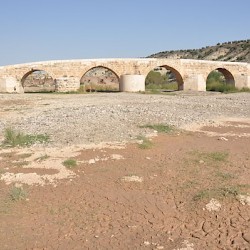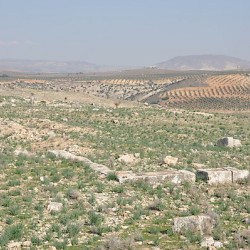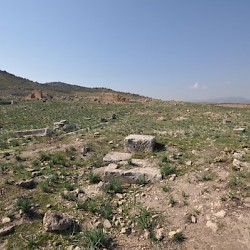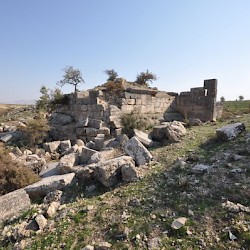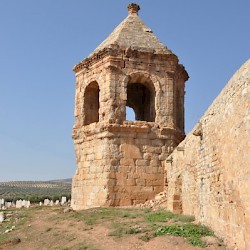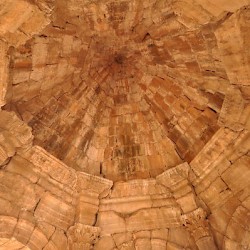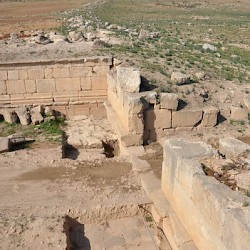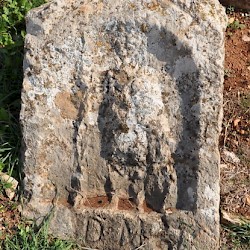Cyrrhus
Q536924Cyrrhus (Greek: Κύρρος): ancient town in northern Syria, base of the Tenth Legion Fretensis.
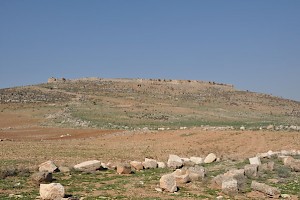
Cyrrhus was founded by one of the Seleucid kings (Seleucus I Nicator or Antiochus I Soter?), probably in the first half of the third century BCE. It was situated at the place where the road from Antioch to Zeugma or Hierapolis (a major cult center on the west bank of the Euphrates) crossed the Sabun, a minor river. Two bridges survive and are still in use. The city, which is named after a town in Macedonia, is situated in a fertile plain, just north of the agricultural settlements that are now known as the "Dead Cities".
Like all Macedonian settlements, the town consisted of a straight and wide main street (about 800 meter long); the course of the walls - now very damaged - was determined by the shape of the site; and there was a large (still unexcavated) citadel on a hill that rises about one hundred meter above the town. It was therefore a typical Macedonian colony, although it did not have the right to mint its own coins, a right that the nearby cities of the Syrian tetrapolis (Antioch, Seleucia, Laodicea, Apamea) did have. Cyrrhus always remained a bit provincial.
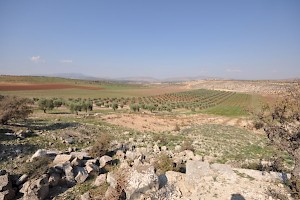
The city remained in Seleucid hands for almost two centuries, but became part of Armenia during the reign of king Tigranes II the Great. He was defeated by the Romans, and the Seleucid Empire was briefly restored, until the Roman general Pompey finally decided to add the old kingdom to the Imperium Romanum. Its strategic position made it inevitable that the city was used as a military base. According to the Roman historian Tacitus, the Tenth legion Fretensis was in Cyrrhus in the year 18 CE.note This unit stayed in the city until is was transferred to Judaea after the great war of 66-70.
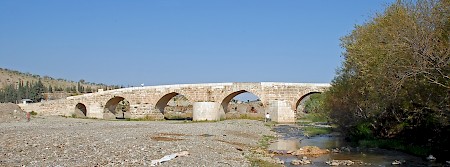
Roman commanders with plans to attack Armenia or the Parthian Empire, east of the Euphrates, often visited Cyrrhus. We know that Germanicus, Trajan, and Caracalla visited the city. The presence of legionaries and other soldiers, and the imperial visits, must have been beneficial to the urban economy; the two bridges were built in this age - in the second century, to be precise. The large theater (diameter 115 meter) was built at about the same time, while the hexagonal mausoleum, probably the tomb of a Roman centurion, belongs to the late second or early third century. The Historia Augusta mentions that the usurper Avidius Cassius was born in Cyrrhus.note
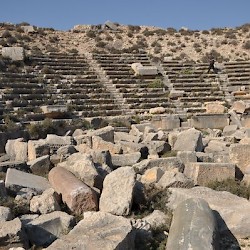 Cyrrhus, Theater, seats |
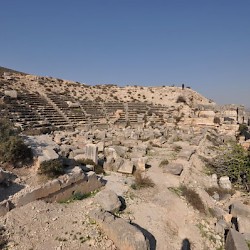 Cyrrhus, Theater |
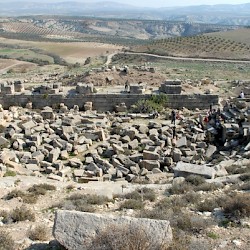 Cyrrhus, Theater |
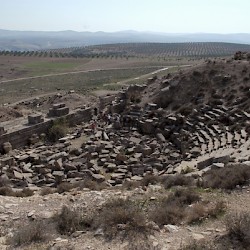 Cyrrhus, Theater |
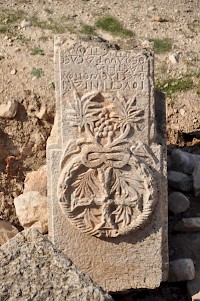
The attacks from Sasanian king Shapur in the third century put an end to Cyrrhus' prosperity: the city was captured at least two times. Still, the Roman army remained in the neighborhood, which means that the city must have kept some of its income. Cosmas and Damian, two Roman soldiers who were tortured to death in 283 when it was discovered that they were Christians, were buried in a beautiful basilica in Cyrrhus.
The new faith must have been well-established at an early date, because we know that a bishop of Cyrrhus was present at the Council of Nicaea in 325. The shrine of Cosmas and Damian attracted many pilgrims, and the city prospered again. It was renamed Hagiopolis, "town of the saints". Bishop Theodoret (second quarter of the fifth century) had the money to restore several old buildings, like the aqueduct, the baths, and the bridges.
According to the Byzantine author Procopius, the walls were renewed by the emperor Justinian;note an inscription from his reign runs:
| Ἰουστινιανοῦ βασιλέωϲ πολλά τα ετῆ Θεοδώραϲ δεϲ- ποίναϲ πολλὰ |
To Justinian the emperor many years To Theodora the emp- ress many years |
Procopius also preserves the legend that the city was not founded by the Seleucids, but by Jews, who - on return from their Babylonian Captivity - wanted to honor their liberator, Cyrus.
The city was captured by Arab armies in 637. The stones of the shrine of Cosmas and Damian were brought to Aleppo, to build the Umayyad Mosque. The hexagonal mausoleum was converted into the sanctuary of a local Muslim saint, and was perfectly preserved.
Excavation has started in 1952.
